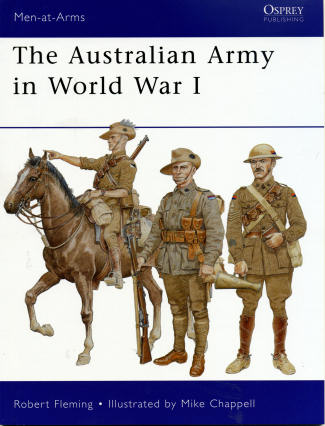 Osprey
has been getting back to WWI with their Men at Arms series, and #478 covers one
of the major participants in that conflict, the Australian Army. Australia was a
fairly young nation in 1914 when the call went out from the British to her
Commonwealth to help provide troops for the war with the Germans and the Turks.
Since the new nation was barely 13 years old, they not only did not have a
unified sense of self, but also did not have a standing army.
Osprey
has been getting back to WWI with their Men at Arms series, and #478 covers one
of the major participants in that conflict, the Australian Army. Australia was a
fairly young nation in 1914 when the call went out from the British to her
Commonwealth to help provide troops for the war with the Germans and the Turks.
Since the new nation was barely 13 years old, they not only did not have a
unified sense of self, but also did not have a standing army.
What Australia did have was a system of compulsory
militia participation and that helped to provide the basis for the initial
Australian division. None of the militia were required to volunteer for overseas
service, but many did and along with the popularity of enlisting in the army,
the first Australian division was formed and sent overseas.
Before they reached Europe, they were sent to Egypt as
it was decided that the Australians and New Zealanders would be the major
players in the operations against the Turks at Gallipoli. This entire operation
was a disaster and despite heavy losses among Entente troops, after over 8
months of stalemate, the decimated divisions were withdrawn to Egypt to re-equip
and get replacements.
In 1916, they finally got to Europe and found that the
death and depredations there made Gallipoli pale by comparison. However,
Australian troops proved themselves to be resourceful and nearly fearless. They
were formidable foes and were often able to achieve objectives where those
before had failed. This was, of course at a high cost. Of the 331,000
Australians that served overseas, 210,000 were casualties of one sort or
another. However, the results of their actions gave Australian soldiers a
reputation and the nation a sense of unified identity.
This book covers all of the different aspects of
Australian Army participation including aviation units and those serving in
Palestine. Each of the major campaigns is covered in some detail. As this series
is generally about uniforms and equipment, throughout the book the author and
illustrator have shown these items as used by the soldiers of the various units.
These are quite varied as while many look at photos of troops and see just
uniforms, often these men were outfitted quite differently from each other.
Thanks to the excellent choice of period
photographs and those done specifically for the book, we get an idea of how these men were dressed and
outfitted. This all makes yet another great addition to the superb library of
Osprey titles and one you can purchase with confidence.
August 2012
For more on the complete line of Osprey books,
visit www.ospreypublishing.com. In the US, it is
Osprey Direct at 44-02 23rd St, Suite 219, Long Island City, NY 11101., where you can
get a catalogue of available books.
If you would like your product reviewed fairly and
fairly quickly, please contact
the editor or see other details in the Note to
Contributors.
 Osprey
has been getting back to WWI with their Men at Arms series, and #478 covers one
of the major participants in that conflict, the Australian Army. Australia was a
fairly young nation in 1914 when the call went out from the British to her
Commonwealth to help provide troops for the war with the Germans and the Turks.
Since the new nation was barely 13 years old, they not only did not have a
unified sense of self, but also did not have a standing army.
Osprey
has been getting back to WWI with their Men at Arms series, and #478 covers one
of the major participants in that conflict, the Australian Army. Australia was a
fairly young nation in 1914 when the call went out from the British to her
Commonwealth to help provide troops for the war with the Germans and the Turks.
Since the new nation was barely 13 years old, they not only did not have a
unified sense of self, but also did not have a standing army.